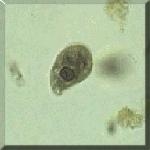Parasites,
Some Different Varieties








There are over 3000 varieties of parasites in four
major categories, Protozoa, Trematoda, Cestoda
and Nematoda.
Nematodes: common roundworms (Ascaris lumbricoides),
hookworms, whipworms, pinworms, heart worms, Strongyloides, Stercoralis,
Ancylostoma, caninum, toxocara worm and trichinosis. Size can
vary from .2 to 35 centimeters.
Roundworms look similar to an earthworm and can
produce 200,000 eggs daily. Approximately 1,008 million people
are infected, making it the most common worldwide. The most frequent
symptom from roundworms is upper abdominal discomfort. Other symptoms
are asthma, eye pain, insomnia, and rashes due to the secretions
or waste products from the worms.
Large numbers can cause blockages in the intestinal
tract, hemorrhage when penetrating the intestinal wall, appendicitis,
peritonitis, abscesses in the liver, hemorrhagic pancreatitis,
loss of appetite, and insufficient absorption of digested foods.
Adults grow to 15 inches long.
Hookworm larvae penetrate the skin. When hookworms
reach adulthood, they can sap the victim's strength, vitality
and overall well-being. Young worms use their teeth to burrow
through the intestinal wall and feed on your blood.
Symptoms from hookworm are iron deficiency, abdominal
pain, loss of appetite, craving to eat soil, protein deficiency,
dry skin and hair, skin irritations, edema, distended abdomen,
stunted growth, delayed puberty, mental dullness, cardiac failure
and death. (1/2 inch long)
Pinworms can infect one in five children. Symptoms
are itching and irritation of the anus or vagina, digestive disorders,
insomnia, irritability or nervousness. Female worms crawl out
of the anus and lay about 15,000 eggs per day. Once airborne,
the eggs can survive about two days anywhere in your living environment.
Worldwide, about 500 million are infected with pinworms.
The worm is white and can grow to about half inch in length.
Infections from whipworms are estimated at several
hundred million worldwide. Symptoms of whipworms are bloody stools,
pain in the lower abdomen, weight loss, rectal prolapse, nausea
and anemia. Hemorrhage can occur when worms penetrate the intestinal
wall and bacterial infections usually follow. 1 to 2 inches length.
Protozoa: the single cell parasites; amoebae,
protozoa infections, neospora, Toxoplasmosis, cryptosporidium,
giardia, Sarcocystis and Trichomonas vaginalis.
Amoebae are an irregular shaped microorganism that
infects the end of the smaller intestine and colon. Amebiasis
is the most common infection and caused by the species Entamoeba
histolytica.
Amoebae also release an enzyme that causes ulcers
or abscesses where they can enter the bloodstream. They can eventually
reach other organs like the brain or liver. (25 micro meters in
diameter)
Cryptosporidium is associated with water-borne outbreaks.
The victim might experience diarrhea and abdominal pain lasting
for about ten days.
Giardia is the most prevalent intestinal parasite
in humans and found in drinking water. Giardia resides in the
smaller intestine and at times in the gall bladder. Millions of
these giardia organisms will coat the intestinal walls, prevents
the absorption of nutrients and later causing illness. Symptoms
are mild to moderate abdominal cramps, intestinal gas, light colored
stools, bad absorption, weakness, chills, stomach bloating and
diarrhea. (14 um x 10 um)
Trichomonas vaginalis are pathogens that resides
in the vagina in females and the urethra, epididymis, and swelling
in the prostate gland in males. In women there is some yellowish
discharge accompanied by itching and burning.
Malaria, the most prevalent and debilitating disease
among the protozoa type is caused by Plasmodium. About two million
people die annually from Malaria.
Cestodes: (Tapeworms); bladder worms, pork
tapeworms, broad fish, dog tapeworms, dwarf and rat tapeworms.
Broad fish tapeworms may grow to 35 feet long and live ten years
inside the persons intestines. Some tapeworms can lay as many
as one million eggs per day. Their bodies are in separate segments
with hooks and suction cups on their skull.
Trematodes: (Flukes); Flatworms, bladder,
blood, liver, lung, kidney and intestinal flukes. Human infections
of flukes (Schistosomes) are in excess of 250 million worldwide.
They can cause severe disease of the gastrointestinal tract, bladder,
liver and destroy blood cells. Size varies from 1 to 2.5 centimeters
in length (1/2 to 3 inches long).
Spirochetes are very tiny organisms that are spiral-shaped,
and multiply in the blood and lymphatic system. Spirochetes (largest),
Saprospira, Cristispira, Treponema (smallest), and many more.
The host or carrier is usually lice, ticks, fleas, mites, and
flying insects, which is then transmitted to humans. Spirochetes
are responsible for relapsing fever, infectious jaundice, Lymes
disease, sores, ulcers, Vincent angina and Wyles disease.

What are parasites
anyway?
What are parasites
anyway?
How did we discover
this powerful formula?

"These
statements have not been evaluated by the FDA.
This product is not intended to diagnose, cure, prevent or treat
any diseases."
The above is a Government ORDERED statement.
It is NOT based in either reality or sanity.
Just like our Government.
In
a landmark decision on Friday, Jan. 15, 1999, the US Court of
Appeals for the District of Columbia ruled that
the health claim rules imposed by the FDA unconstitutional
and in violation of the Administrative Procedure Act.
The court instructed the FDA to allow the use of disclaimers on
labels rather than to suppress these claims outright.
The court further held prohibiting nutrient disease relationship
claims invalid under the first Amendment to the Constitution.









